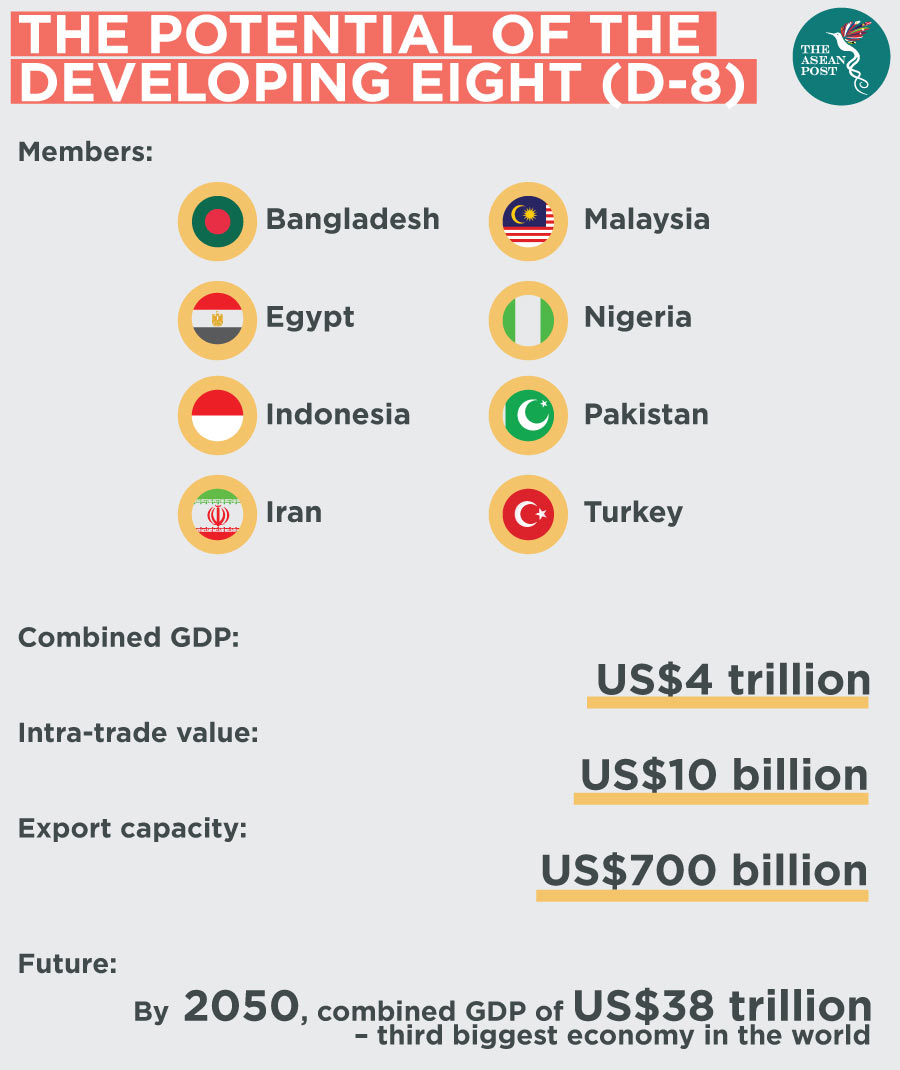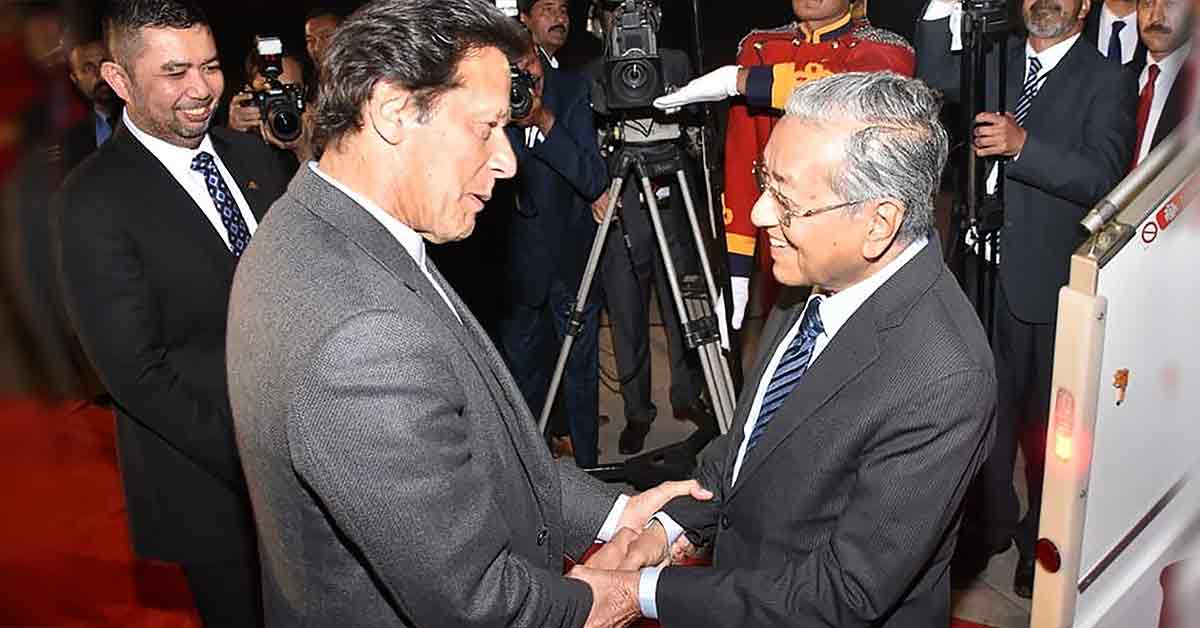With Chile withdrawing from its role as this year’s host of Asia-Pacific Economic Cooperation (APEC), attention is now shifted towards the 2020 Summit which will be hosted by Malaysia. Whilst APEC has been an integral part of Malaysia’s regional and international credential and status, there are other smaller groupings which deserve attention. One of these is the Group of Developing Eight (D-8).
Even though the D-8 has been in existence for some 20 years, the “output gap”, i.e. the “economic potential”, is gaping wide and has been the case for many years.
Globalisation flows as understood in terms of trade and investment between Malaysia – D-8 have not taken off as compared with other countries such as the United States (US) and China. It is not even the case of a one-sided bilateral relations where one side, namely Malaysia, enjoys a burgeoning trade surplus vis-à-vis the other country as is the case with India. But in common with the broader trend involving the Organisation of Islamic Cooperation (OIC), of which the D-8 member-countries are also concurrent members, trade and investment trends have under-performed and not fully materialised according to the huge potential there is.
In the current circumstances of global economic and financial uncertainty and instability, instead of pursuing a “de-coupling” strategy which - for all the talk - has never taken root in the first place, perhaps the better and more normal route would be to further “diversify” our “portfolios” or, rather, global markets as well as forging and fostering strategic partnerships and alliances (e.g. economic “bandwagoning”) – to create more business opportunities and at the same time cushion the impact of a slowdown caused by geopolitics and geo-economics.
The time has come for Malaysia to seriously and pro-actively elevate and further develop its relations with the D-8 – moving beyond a show of solidarity and technical cooperation (of which we have shouldered much of the burden and played a major part). This is to ensure that it’s prime minister, Mahathir Mohamad’s, vision of “prosper-thy-neighbour” is fully materialised.
The D-8’s combined GDP amounts to US$4 trillion, its intra-trade is valued at US$10 billion of intra trade and has a US$700 billion of export capacity. PricewaterhouseCoopers has projected that by 2050, D-8 member states will rank among the top 24 economies of the world and, with a combined GDP of US$38 trillion, the D-8 could become the world’s third biggest economy.

Indeed, with Malaysia holding the post of secretary-general of the D-8 - hence assuming the role and responsibility of driving the agenda and mission of the organisation - we are well-placed and poised to shape and influence its direction moving forward.
As reaffirmed by Bangladesh State Minister for Foreign Affairs Md Shahriar Alam, in conjunction with a visit from the D-8 secretary-general, Ku Jaafar Ku Shaari, the member-country is committed to “a more effective and functional D-8 realising its full potential” in the fields of technology and innovation, universal health care services, in the newly established chamber of commerce and industry, and establishing Free Industrial Zones (FIZs).
How Malaysia can benefit
As it currently stands, D-8 cooperation is still seen to be low-key in Malaysia’s foreign policy and diplomacy. It deserves to be placed on par with Malaysia’s Look East Policy as well as the Regional Comprehensive Economic Partnership (RCEP) and the Comprehensive and Progressive Agreement for the Trans-Pacific Partnership (CPTPP).
D-8 should be conceptualised and envisioned to be a spring-board, bridge-head and gateway for Malaysia to further penetrate other markets. For example, Malaysia could leverage and capitalise on Turkey’s proximity and access to the EU market of 500 million – via supply chain integration, industrial linkages and production network within the Turkey-EU Customs Union. Proton automotive destined for the Southern European market could be assembled in Turkey, for example.
At the same time, Malaysia should encourage and push for Turkey to apply for membership of the European Economic Areas (EEA) – since the country only has a modified Customs Union (excluding agricultural, coal and steel products, public procurement). As part of the move to incentivise gaining of admittance and accelerate approval, supplementary and complementary measures should be put in place first as the initial step to present the EU with a negotiating element or advantage and opportunity costs.
With Turkey’s membership of the EEA, the EU will gain the opportunity to derive FDI from leading ASEAN countries such as Malaysia (as also the largest ASEAN trading partner for Turkey) – in view of the impasse reached and suspension of talks between the Malaysia and the EU on a proposed FTA.
Malaysian companies already based in Turkey would have their expansion drive into the broader EU market facilitated. And stronger business-to-business (B2B) between Malaysian companies and their EU counterparts could be forged and fostered pending the recommencement of negotiation between the two. Not least, stronger bilateral relations between Malaysia and Turkey under the present administrations should be capitalised as fulcrum and catalyst in spearheading the agenda of the D-8(!)
It is vital that the D-8 be not “insular” but must be conceived by Malaysia as a bridge directly linking the OIC world with the non-OIC world and indirectly with the respective regions in which the member-states are strategically and propitiously positioned.
If one were to look at the map, all eight member-states together eminently and elegantly appear as a “chain” or “string of pearls” and “crescent” (“concave”). It could well be argued that such a picture is a signal reminder and hence embodies the shifting of influence and power from the North to the South (and not only from the West to the East).
Malaysia as a rising or emerging middle power (including its own projection and influence of soft power such as being a well-known progressive Muslim country and leading voice of the D-8 as in effect constituting a “bloc” within the Islamic world) is well poised to play a prominent role as a role model of a developing country rapidly transitioning to a developed country status. The D-8 (as also representing Malaysia’s own multilateral economic diplomacy) – with its six priority areas of agriculture, trade, transportation/ logistics, manufacturing industries, energy and tourism – could well prove to be one of the catalysts in this regard, i.e. of both economic development on the back of the halal industry alongside the increasing integration and mainstreaming of the halal industry into the broader trade and investment relations.
Meanwhile, Malaysia should also position itself as the eminent gateway and “portal” for the other D-8 member-states to access and export to the wider APEC market. In straddling between the D-8 and APEC, Malaysia once again proves its standing and stature as a strategic pivotal and neural point for both the Asia-Pacific on the one hand, and Indo-Pacific world and beyond on the other.
Jason Loh Seong Wei is Head of Social, Law and Human Rights at EMIR Research, an independent think tank focussed on strategic policy recommendations.
Related articles:
